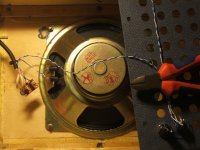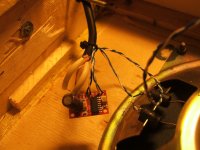I am building a "ghettoblaster" that is a single fullrange driver system. I have got PAM8403 (datasheet) 3W stereo amplifier board, circuit follows datasheet design.
Here's my question: can I parallel those two amplifier channels? If possible, would there be any advantage doing so, e.g. lower damping factor, more powerful bass?
Here's my question: can I parallel those two amplifier channels? If possible, would there be any advantage doing so, e.g. lower damping factor, more powerful bass?
Normally, I don´t suggest to parallel devices. As with transformers, or batteries wired parallel, always there exists a current circulating inside the device, that is wasted from supply and doesn´t go to load. Imagine the following situation: amplifier A gets input at a specific moment, a 10mV input. the amplifier amplifies it 100 times, output goes to 1000mV. The same signal goes to amplifier B wired parallel to amp a, but by manufacturing tolerances, it has 101 times gain, then the output goes to 1010mV, 10 mv plus that A. Suppose an output impedance of, say, 1ohm each. Then, 10mV over 2 ohms (the impedance between the amp A and B), means 20mA wasted in heating both amplifiers, and from supply, but load doesn´t see. Add to it, thermal derivative, noises, input current and voltages offsets between them, the result is a very poor performance as I can see. And with unpredictable fatal failures.
Salu2.
Salu2.
Thank you for your responses! Especially interesting was the article from www.teco-audio.com
My main concern was that PAM8403 is a class-D amplifier and therefore totally different from class-AB amplifiers. I guess it is even more complicated to bridge or parallel them.
Anyway, seems that one channel of PAM8403 is sufficient to drive a 4W 92db vintage fullrange speaker to decent sound levels without distortion. Power supply with 3 AA alkaline batteries or rechargeable batteries (3.6 to 4.5 V). I also added extra 220uf low ESR capacitor near the chip. The second channel of that stereo amp is going to stay quiet with its input tied to ground.
Amazing little chip. Only disadvantage is quite high audible hiss (also with input tied to ground) but in "ghettoblaster" it is not a problem. Some pictures soon!
My main concern was that PAM8403 is a class-D amplifier and therefore totally different from class-AB amplifiers. I guess it is even more complicated to bridge or parallel them.
Anyway, seems that one channel of PAM8403 is sufficient to drive a 4W 92db vintage fullrange speaker to decent sound levels without distortion. Power supply with 3 AA alkaline batteries or rechargeable batteries (3.6 to 4.5 V). I also added extra 220uf low ESR capacitor near the chip. The second channel of that stereo amp is going to stay quiet with its input tied to ground.
Amazing little chip. Only disadvantage is quite high audible hiss (also with input tied to ground) but in "ghettoblaster" it is not a problem. Some pictures soon!
Hi I was also looking at getting this baby amp board to play with; I also want to make a portable speaker box for my ipod/smartphone. You mentioned there is a hiss? Does it get louder with higher volume? More picture would be fantastic!!!
Dears
PAM8403(H) has 2 amplifier stages inside. Each one is bridge type, in order to apply the maximum (rail to rail) voltage to the loudspeaker. So, if you tie together the amplifiers outputs thinking to double output power with the same loudspeaker, you are out of way. So doing you'll have double current capabilities only and you'll have to half loudspeaker impedance (I say 2ohm) in order to obtain more output power.
Anyway you'll have a problem: if the amplifier have different duty cycles (also slight) we'll have a current circulating between the outputs stages and this is evident measuring the current consumption without signal. This will increase power dissipation, lower the efficiency and potentially fail your device.🙁
The only way you can follow if you want double the power and use one loudspeaker only: place a transformer with 2x 4ohm primary windings (having low match between) each ones individually wired to an amplifier output, obviously the secondary will be suited for the loudspeaker impedance.
Have you a nice day
PAM8403(H) has 2 amplifier stages inside. Each one is bridge type, in order to apply the maximum (rail to rail) voltage to the loudspeaker. So, if you tie together the amplifiers outputs thinking to double output power with the same loudspeaker, you are out of way. So doing you'll have double current capabilities only and you'll have to half loudspeaker impedance (I say 2ohm) in order to obtain more output power.
Anyway you'll have a problem: if the amplifier have different duty cycles (also slight) we'll have a current circulating between the outputs stages and this is evident measuring the current consumption without signal. This will increase power dissipation, lower the efficiency and potentially fail your device.🙁
The only way you can follow if you want double the power and use one loudspeaker only: place a transformer with 2x 4ohm primary windings (having low match between) each ones individually wired to an amplifier output, obviously the secondary will be suited for the loudspeaker impedance.
Have you a nice day
I have the same board here..and planning to build a small portable MP3/ FM radio, my question is abt a capacitor named C7 on the opposite side of PCB where the chip is located. is this a supply filter capacitor ?
- Status
- Not open for further replies.
- Home
- Amplifiers
- Class D
- paralleling PAM8403 two channels

